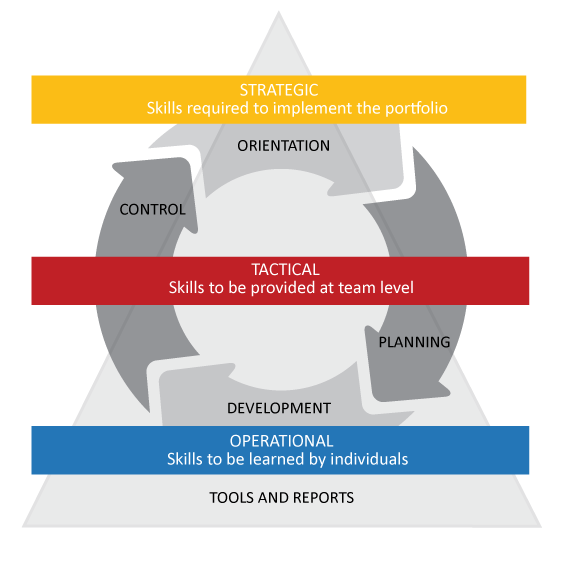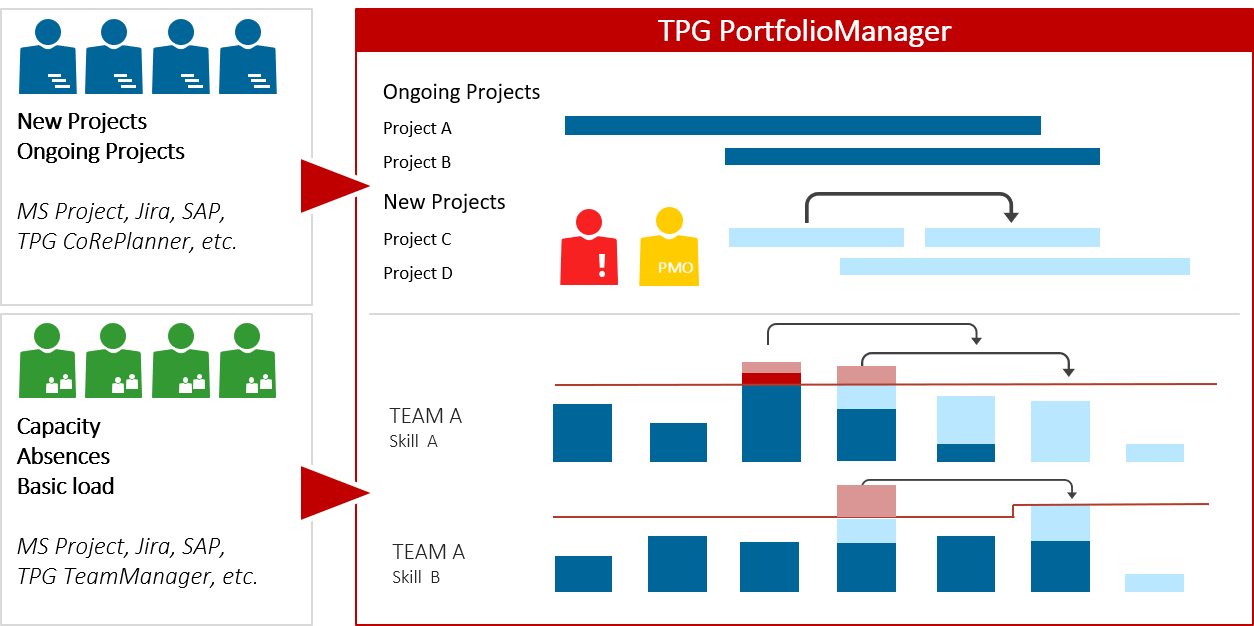Resource management is a huge challenge for many companies. Which staff member to use for what project? And when? This is not only about the availability but also about the skills of the staff members. Yet, how do you ensure that the demand for certain skills is covered? Skills management will pave the way.
Short definition: Skills management deals with the knowledge and abilities of employees or teams. It helps to refine resource planning and respond to the demand from the projects in a targeted manner. The 3 types are: strategic, tactical and operational skills management with areas like human resources development, creating profiles and gap analysis or review of learning goals.
This article will show you:
- in which areas to use skills management
- what benefits and challenges are in store for you
- how to introduce skills management at your company
More precisely, you will learn about the following topics:
- What is skills management?
- The benefits of skills management
- The challenges of skills management
- How to introduce skills management
- Skills and capacities
- Skills in tactical resource planning
- Long-term focus when assigning resources
- Organizational changes
- The strategic benefits of skills management
- Conclusion
Note: By tactical resource planning, we mean the coordination between project and line managers. It depends on the company’s form or organization (matrix or line). The goal is to meet the requirements for resources with the necessary skills for projects in a timely manner using staff from the line. This tends to be the team leaders’ task.
What is Skills Management?
Skills management is a powerful tool for using resources efficiently in projects. It has a strategic, a tactical and an operational aspect.
Strategic: From a strategic perspective, skills management is a combination of knowledge and human resources (HR) management. The aim is to determine the different skills required and the corresponding capacity requirements. This must be based on the strategic focus. It is possible to set priorities in good time to advance the desired long-term development of the workforce.
Tactical: Tactical skills management is a whole different story. Team leaders have to provide the right number of suitable staff for the required dates. In consultation with the HR department, they must look after their staff’s training and induction.
Operational: As part of their career management, individuals receive training and development according to the requirements of their teams.

The Benefits of Skills Management
Skills are abilities possessed by a team member at the company. Usually, each team member will possess several skills. These can be software skills, product-specific knowledge, certifications (e.g. as a project manager) or languages.
Special Download: 3 Important Points for your Tactical Resource Planning (PDF file)
Please fill in the form.
* Required Fields | Data Protection
From the project management perspective, skills management represents a more flexible management of resources. It makes it possible to define the resource requirements for the projects not as individuals but generically as skills.
Thus, it becomes faster to determine – in principle and before the project start – whether a project can be carried out with the available capacities and skills. In subsequent weeks / months, the generic resources will be replaced by individuals bit by bit.
Learn more about tactical resource planning: Project Resource Management
This approach carries an important benefit. With generic resources, you will have to put less effort into rescheduling projects. After all, no individuals are scheduled for activities further in the future whose availability might change in the meantime.
This even permits a tool-based automatic resource allocation, if the skills of the staff are registered accordingly. However, this approach does not consider social aspects or other soft factors which are usually impossible to reproduce in software.
This is why such methods often do not produce optimal results. In such a case, software can make suggestions. But it will not be able to fully replace good collaboration between project managers and team leaders.
The added value for the company is that deficits become visible. As a result, these can be addressed specifically. Therefore, you should always aim to have a team with predominantly evenly distributed knowledge.
This makes it easier to distribute the requested skills to all team members. The fewer differences exist between the team members’ skills, the less complicated the planning and redistribution will be.
Flexible personnel placement is also a key factor in strengthening competitiveness.
Our tip: Try to spread the knowledge as evenly as possible within the teams. The fewer differences exist between the team members’ skills, the less complicated it is to plan and reallocate the requested activities.
The Challenges of Skills Management
The most important prerequisite for making skills management work is this: the abilities of the staff members have to be documented as fully as possible. In bigger companies, this will not be possible without the approval of the employee organization.
Gathering the employee-related data is one of the biggest challenges. Once their skills become transparent, staff members often fear disadvantages compared to other colleagues. This concerns e.g. personnel decisions such as promotions or lay-offs.
Learn more about the significance of skills management in the PM Trends article.
You will only be able to alleviate these fears on the part of the staff, if both sides derive real benefit from skills management. At any rate, you should ensure that the recording of skills is integrated in a consistent personnel development plan. It can include, for example, further training, incentive systems or the like.
This enables staff members to see a benefit for themselves. After all, they have improved opportunities to further develop their own skills and increase their value for the company. Once the staff see more advantages than disadvantages, you will be more likely to obtain the necessary acceptance for skills management.
Our tip: Alleviate the fears on the part of the staff and further the acceptance of skills management with a consistent personnel development plan. The collaboration with the responsible bodies is a vital prerequisite for this.
How to Introduce Skills Management
A first step towards the introduction of skills management can be to record the skills by teams rather than individuals. In such a case, the team leader names the skills of his or her team in general.
But this makes the team leader the only one who can select individuals from the team according to their abilities. By and large, this rules out an automated selection.
On the one hand, this anonymization of skills will help you reduce the fears of the staff mentioned above. On the other hand, it may reduce the motivation in the teams, as there is a lack of personal incentives.
Free Download: eBook “Tactical Resource Management” (more than 80 pages)
Resource planning between project managers and team leaders is always a challenge in project management. In this free eBook, you will learn how meeting this challenge can become easier.
> Click here to download your free copy of the eBook.
You would take a different approach if you wanted to plan the individual skills for each person. In that case, each member of staff should be requested at regular intervals to update his or her own data and to align them with the responsible team leader.
An even better system for skills management can be achieved if you also document the level of the skills. This gives you the details of how well certain skills are commanded by the respective team member. In the end, it is essential to know whether a newcomer can be assigned to a task or if it requires an expert.
However, this is also the most sensitive point for agreement with the employee organization. But as long as the staff members declare this themselves or a uniform qualification system exists, you should be able to overcome this hurdle, too.
Skills and Capacities
Each team member has an employment contract. From the capacity of weekly or monthly working hours, it is possible to calculate the project availability after subtracting vacation times and operations.
Ideally, you will have several people with the same skills on one team. In such a case, their availabilities can be added. For example, you may receive requests for three people of which you have ten on your team. You can respond to the requests easily by looking at these team members’ remaining availability.
But how would it be if your team members had different skills?
Your ten engineers can handle five different technologies, but not each of them can handle all five. Some may be able to handle only one, others may command all five.
The capacities and availabilities of the team members with multiple skills should be considered irrespective of the number of skills.
Example: If it is possible to have one team member, who is project manager, software developer and database administrator, you still have one team member with three skills rather than three team members with one skill each. Therefore, you cannot state capacities per team member and skill in such a case, but only per team member.
Someone may ask about the available capacity for software developers or database administrators. The answer might be eight for the first case and five for the second. But you only have ten people on the team. Still, the answer would be correct as long as the requests do not come all at once.
After all, your individual team members cannot do everything at once. At times, they will only be able to do the one thing or the other.
For the dilemma of the multiple skills, the following suggestion exists: You allocate half the capacity for one skill to the respective person and the other half for another skill. But watch out: this would entail that an overload situation would appear in the case of an engagement of over 50 percent for an individual even though he or she still has remaining availability.
This is why we recommend the normal allocation of the capacity to the individuals, regardless of their skills. The skill allocation per person ensues step by step.
Our tip: Allocate the capacity to the individuals regardless of their skills at first. In a second step, perform the skill allocation per person.
Skills in Tactical Resource Planning
In the line organization, skills management at a tactical level is not very challenging. The project manager will forward the required work packages to the team leader. The latter knows the skills within his or her team. Thus, he is able to assign them optimally.
Yet, with the matrix organization, the project manager has to define the requirements for the desired project staff members. These can be checked for accordance and availability against the available skills in the different teams. Good skills management can speed up this process considerably and also improve it. With it, it will transpire quickly which skills are required, who matches these at which site and how well. And who is also available besides.
A degree of anonymization will come with a growing number of people to assign and their dispersion across different sites. This can actually be of advantage. It forces project managers to directly request skills rather than people, as they do not actually know the people.
Without skills management, they will only ever request the resources they know directly. Thus, specialisms will come sneaking in, which is doubly risky. The specialists are booked constantly and also overbooked, as alternative people for the tasks are “unknown”.
However, this will not give the “known” people time to share their knowledge, nor will it benefit their health. And in the worst case resources, which are already scarce, become absent unexpectedly. This will be much more painful than maintaining a system for skills management.
What is more, requesting skills rather than people forces the project managers to formulate the requirements more precisely. This in turn enables the team leader to distribute the work more evenly among all suitable individuals.
Our tip: Rely on requesting skills rather than people. This allows the team leader to distribute the work more evenly among all suitable individuals.
Long-Term Focus When Assigning Resources
When assigning resources to projects, you can distinguish between two approaches:
- You focus on the advantages for the project: as a planner, you employ largely those team members that best meet the requirements. These individuals will carry out the tasks fastest and with high quality.
- You focus on the advantages for your company: you rely more heavily on individuals who do not (fully) possess the required skills. These will develop in the course of the project and acquire the required know-how. This may take longer, the profit may be lower, but you create knowledge. The project will have disadvantages, but the company will profit.
Try to follow the second approach whenever possible. Ultimately, more people with frequently required skills become available this way. This makes future human resource planning more flexible.
In addition, you reduce the danger of exclusive knowledge. This decreases your company’s dependence on individual people.
At the same time, the motivation of these knowledge bearers may increase if they get the opportunity to learn, become more important, and can accomplish more than just routine jobs.
Our tip: As a team leader, rely more heavily on individuals who do not (fully) possess the required skills. This makes your future human resource planning more flexible, as you create knowledge in this way.
Organizational Changes
When planning with staff skills, it is irrelevant for the project manager which organizational unit a resource belongs to. All he or she needs is a note as to whether there is sufficient capacity for the required skills at the required date.
Ideally, the software used would suggest to the project manager which resources at the company possess the required skills. And he or she would learn whether the latter are available during the desired period of time.
Another interesting read: Software Tools for Resource Planning – The Requirements
If skills management is done consistently, the request from the projects will not be addressed to the team leader directly. The future coordination process of tactical resource planning will be possible e.g. via central resource managers or a Project Management Office (PMO).
This becomes possible, because the company organization structure changes accordingly. Certain resources could be allocated from a central and location-independent pool.
Ideally, you would have staff used only in projects on the one hand. These staff members would not have to carry out any operations except for team meetings.
On the other hand, you would have staff members only carrying out operations who would not be used in projects.
This further increases the plannability in the team. However, this is only possible where the tasks can be separated clearly, too. For this, the workload on both sides, i.e. for project activities and operations, must be stable enough to omit the necessity to change over and over again.
Besides, you have to consider the acquisition of knowledge, which is often required on both sides.
The Strategic Benefits of Skills Management
Let us briefly look at the strategic aspect of skills management once again. In project portfolios, it will reveal if bottlenecks for capacities and skills are to be expected. And when. It becomes possible to counteract these in good time. Targeted training, recruitment and cooperation are ways to prevent future bottlenecks.
Besides good skills management, successful strategic capacity planning requires an enterprise-wide resource overview. The graphic below shows how a tool based on an enterprise-wide resource pool can support the dynamic assignment of skills and staff members to strategically valued projects.

Interesting for strategic resource management: Capacity Planning in Project Management
But skills management is also beneficial in the opposite case: you learn early when you will no longer require what knowledge. From a strategic perspective, it is essential to combine these approaches. This method allows you to train people with skills that will be less sought-after in the future to meet new demands in good time.
Conclusion – Why to Use Skills Management
This article has taught you that skills management is a very advanced form of resource management. You are now familiar with the most important benefits from a strategic and tactical-operational point of view.
But it will not be easy to establish this approach. Reservations on the part of the staff members who fear disadvantages for themselves are very common. It is possible to alleviate these if the high effort for recording the skills is tied in with concepts for personnel development.
And you know now that you should focus on requesting skills rather than individual people. This allows the team leaders or resource managers to distribute the work more evenly among all suitable individuals.
Is there anything you would like to add regarding skills management? What gives you a headache? We’ll be happy to respond to your comment below!
About the author: Johann Strasser, a certified engineer, has been a managing partner at TPG The Project Group since 2001. After many years as a development engineer in the automotive and energy sectors, Johann Strasser spent a decade as an independent trainer and consultant in the field of project management. During his tenure, he also served as project manager for software projects in the construction industry and provided scheduling and cost management support for large-scale construction projects. At TPG, he applies his expertise in product development and consulting services for international clients. His special focus is on PMO, project portfolios, hybrid project management, and resource management. For many years now, he has shared his knowledge through presentations, seminars, articles, and webinars.
You can read more about Johann Strasser on LinkedIn and XING.






